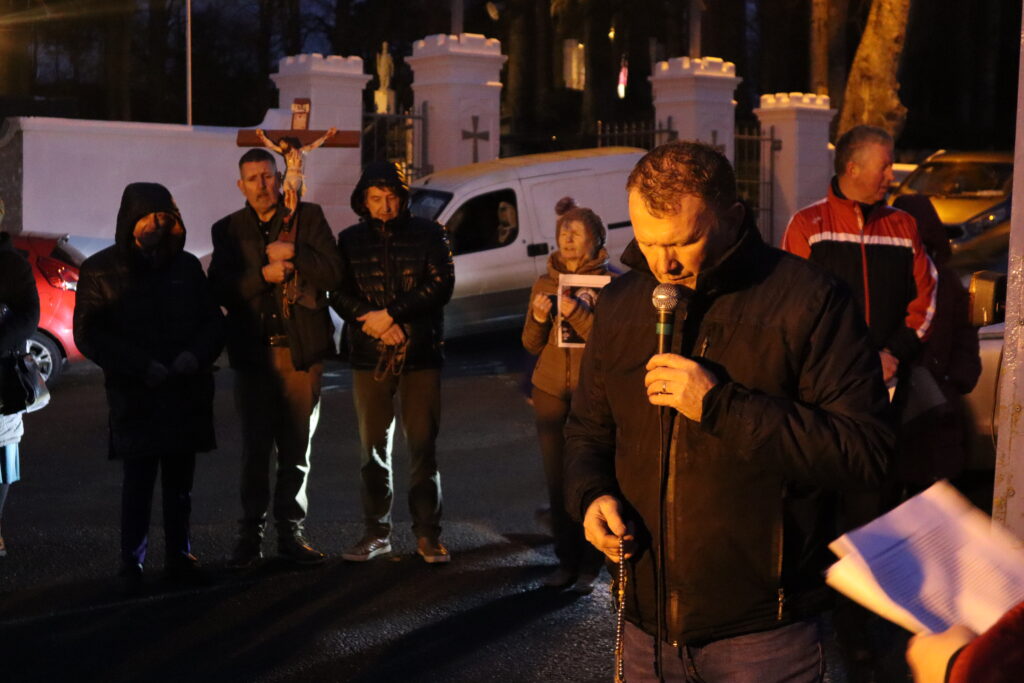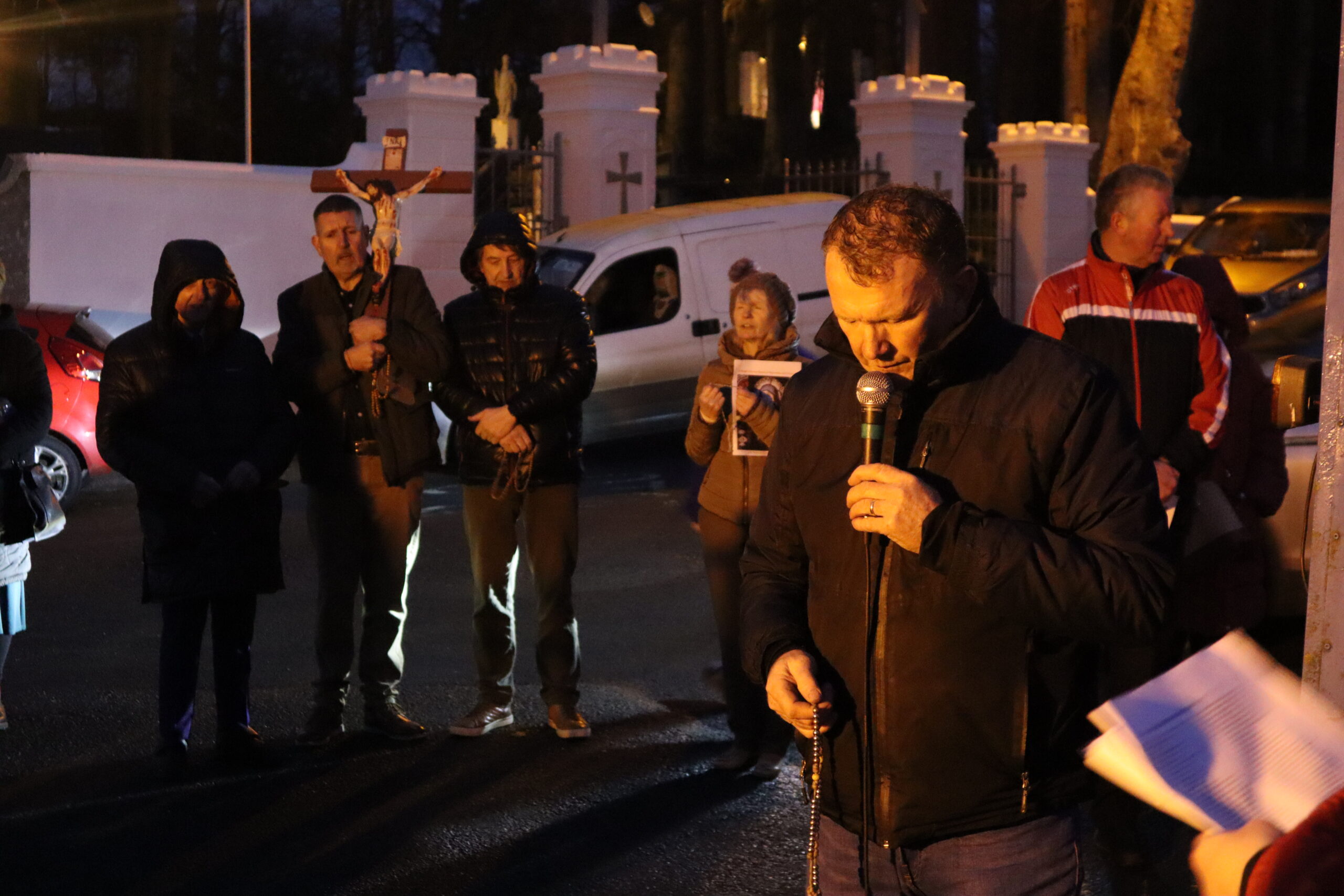by Philip M. Beattie

On Sunday 29th January, around 150 faithful Irish Catholics congregated on a bitterly cold and rainy evening at St. Brigid’s Oratory, Hill of Faughart, to offer the peaceful prayer of the Rosary in reparation to God. The maternal intervention of Our Blessed Lady and the Hand of Divine Providence were not lacking. Indeed, it was announced that this pagan event celebration had been cancelled that day owing – according to the organisers – to “a lack of tickets sold online”.
With the neo-paganisation of Catholic Ireland advancing with the government’s blessing and endorsement, militant Irish Catholics praying the Rosary in reparation have continued to make their voices heard. This latest episode concerned the planned “celebration” commemorating St. Brigid as a so-called Celtic “Goddess” of healing and fertility, scheduled for Sunday 29th last at St. Brigid’s Oratory, located at her shrine in Faughart, Co. Louth.
St. Brigid, secondary patroness of Ireland, was born in Ireland as Brigit in 451 AD, and it is widely believed her mother was Brocca, a Christian baptised by St. Patrick, and her father was Dubthach, a Leinster chieftain. Brocca was a slave, and therefore Brigid was born into slavery. There are many stories that deal with Brigid’s purity throughout her life. She was unable to keep from feeding the poor and healing them. She made a vow to always be chaste, and, having been freed from slavery, took her vows as a Christian nun.
While little is known about her life after she entered the Church, what is clear is that she founded a monastery in Kildare, called the Church of the Oak, one that was built above a pagan shrine to a Celtic pagan deity. It is indisputable that St. Brigid helped many people in her lifetime, but on February 1, 524 AD, she passed away of natural causes. Her body was initially kept to the right of the high altar of Kildare Cathedral, with a tomb “adorned with gems and precious stones and crowns of gold and silver,” but in 878, during the Scandinavian raids, her relics were moved to the tomb of St Patrick and St Columba.
In 1185, John de Courcy had her remains relocated in Down Cathedral. Today, Saint Brigid’s skull can be found in the Church of St. John the Baptist in Lumiar, Portugal. The tomb in which it is kept bears the inscription: “Here in these three tombs lie the three Irish knights who brought the head of St. Brigid, Virgin, a native of Ireland, whose relic is preserved in this chapel. In memory of which, the officials of the Altar of the same Saint caused this to be done in January AD 1283.” A portion of the skull was relocated to St. Bridget’s Church, and another was sent to the Bishop of Lisbon in St. Brigid’s church in Killester.
The planned exercise in pagan-induced syncretism and pantheism, aimed at conflating a Christian saint with a pagan deity was shocking. This event was scheduled by the pagan group, Brigid of Faughart, to coincide with the traditional feast day of this Irish Christian saint on 1st February, but celebrated as the Celtic festival of Imbolc by neo-pagans and Wiccans, who have observed Imbolc as a “religious” holiday marking the beginning of spring. This pagan event is held about halfway between the winter solstice and the spring equinox. Tickets for the event which was to include pagan poetry readings, music and pagan singing, meditations as well as readings on St.Brigid the Celtic Godess were available online at €10 per person, in addition to a €1.50 booking fee.
Concerned at the doctrinal confusion that such a resurgence of neo-paganism would engender among Irish Catholics, a friend alerted Ireland Needs Fatima about the impending event. In response, Ireland Needs Fatima swiftly contacted its supporters and correspondents to oppose this abomination, legally and peacefully, by praying the Holy Rosary in reparation outside St. Brigid’s Oratory in Faughart on the day and time planned for the neo-pagan profanation. The Ireland needs Fatima counter-initiative was promoted by The Men’s Rosary of Ireland and Radio Maria.
Thus, what began as a Rosary of Reparation turned into a Rosary of Thanksgiving by Irish faithful Catholics opposed to the neo-paganization of their country.
This year, it is more crucial than ever that we turn to prayer and intercession to increase devotion to Our Lady across our country. That’s why you’re invited to join us in the Three Hail Marys Pledge, a powerful devotion that can bring personal spiritual benefits and national transformation. By reciting three Hail Marys daily, you honour the Immaculate Heart of Mary and seek her intercession for the conversion of sinners, the salvation of souls and the restoration of Ireland’s Catholic Faith. This ancient devotion, revealed to Saint Mechtilde, promises spiritual benefits including protection from mortal sin and the assurance of a good death. Your daily prayers will contribute to an increase in devotion to Our Lady, the conversion of sinners and the moral renewal of our country. Let us commit to this powerful devotion and seek the guidance and protection of Our Lady.

Leave a Reply to Edward Cancel reply